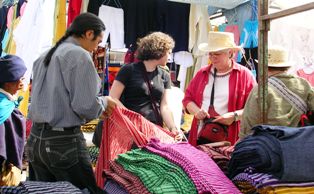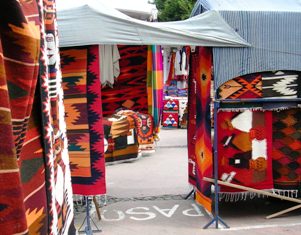Thursday, February 02, 2006
Otavalo
 Every time we go to Ecuador, we make a pilgrimage to the town of Otavalo. We sometimes ride the bus, hire a driver, or rent a car to get there, but every trip is a unique experience even though the merchandise at the market tends to be the same. Otavalo is a small town north of Quito that is ordinary in many ways. It has several
Every time we go to Ecuador, we make a pilgrimage to the town of Otavalo. We sometimes ride the bus, hire a driver, or rent a car to get there, but every trip is a unique experience even though the merchandise at the market tends to be the same. Otavalo is a small town north of Quito that is ordinary in many ways. It has several  central plazas with churches and narrow dirty streets. But it is home to the largest market of indigenous crafts in South America.
central plazas with churches and narrow dirty streets. But it is home to the largest market of indigenous crafts in South America.As you walk into the city and approach “poncho plaza”, you are seduced by an increasing number of local artisans with various handcrafted goods for sale. The market commands a square block and spits out into all the adjoining arterial streets. It not only sprawls horizontally, but in tall vertical stacks of multicolored table cloths, hammocks, sweaters, and shawls.

The market dominates your vision with bright colors and interesting textures. It is not especially noisy, however. The local artisans are quiet and polite. As you walk down the aisles, the sellers will quietly point out the benefits to their particular goods. If you make eye contact, they pick up items to show you the finer points. If you express an interest, they will try hard to find just the right one for you. We never pay the price they originally quote. We have become very talented at dickering in a very friendly and respectful fashion. It works out great. We usually feel that we have found a very low price and they know that they have made a respectable profit. Sometimes, as we are looking or thinking, they converse among themselves in Quichua, the ancient Indian language, which bears no resemblance to either English or Spanish.
 The market is run by a very successful collective of Indian artisans. If you see a table of Ecuadorian woven goods on a street corner or university mall in the US and it is staffed by a short brown man, he is probably from Otavalo. In fact, he is actually probably from Peguchi, a small village on the hillside above Otavalo. We have stayed in Peguchi and have seen numerous people toting large bundles of woven goods, woodcarvings, or vegetables to the market. I have asked street-corner vendors and purveyors of Andean music in Portland if they are from Peguchi and the answer is always a surprised “yes”.
The market is run by a very successful collective of Indian artisans. If you see a table of Ecuadorian woven goods on a street corner or university mall in the US and it is staffed by a short brown man, he is probably from Otavalo. In fact, he is actually probably from Peguchi, a small village on the hillside above Otavalo. We have stayed in Peguchi and have seen numerous people toting large bundles of woven goods, woodcarvings, or vegetables to the market. I have asked street-corner vendors and purveyors of Andean music in Portland if they are from Peguchi and the answer is always a surprised “yes”.We will continue to return to Otavalo at every opportunity even though we buy less. The overall experience is worth the trip.

Comments:
<< Home
This I would love to see! (Well, and the orchids and the birds and the hillsides of Quito and Emily's school and the chocolate and, and, and...) Judging from the pictures I would most likely succumb to sensory overload fairly quickly, but being a "fabric-feeler" and color junkie from way back, I'd be in heaven before they carted me away!
I meant to comment on the entry a few days back--I had never heard of dulce de leche before Emily mentioned it and now I see it surprisingly often here in the US. I am hooked on the stuff! I have the palate of a 5-year-old and the dulce satisfies my overactive sweet tooth. I'd love to make it some time but don't have the courage to do it the recommended way--boil an unopened can of sweetened condensed milk. I can only imagine the explosion! But Hershey has come to my rescue. Last week I snarfed down a bag of Hugs (their white chocolate Kisses) that were filled with dulce de leche. Yummmmmm!
Your blog brings back sooo many memories. We stayed at an old colonial hotel downtown, the Hotel Otavalo. We were serenaded by local Indians playing pan pipes. The market is fabulous. Got there early for the animal market. I think they bring their cattle to market to get them bred! Similar to your photo of a lady with a child carried on her back, saw an old lady with a pig on her back.
Post a Comment
<< Home


